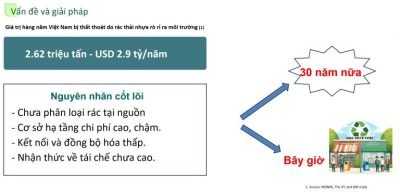Cooperation in building Green point at school
Proposal: Building “Green Points” at Universities and Schools
- Introduction
In the context of climate change and increasing environmental pollution, universities and schools play an important role in educating and promoting environmental protection initiatives. Building “Green Points” at schools will help create a space where students and lecturers can participate in environmental protection activities, thereby forming sustainable living habits, increasing awareness of protecting the planet and facilitating recycling and waste classification.
Green Point is a smart recycling point model, applying technology to collect and classify recyclable waste right at schools, while providing educational solutions on environmental protection for students.
- Objectives
- Create a space for collecting and sorting recyclable waste, helping to reduce waste at schools.
- Build environmental awareness and encourage students to participate in recycling and waste sorting activities.
- Provide learning opportunities through practical activities related to environmental protection and sustainable consumption.
- Combine education with technology, helping students understand and directly experience environmental protection solutions.
- Project scope
- Implementation location: Green Point will be deployed at universities, schools on central campuses, or areas that students can easily access.
- Types of recyclable waste: Including plastic, paper, metal, electronic waste, and other types of waste that are difficult to sort.
- Technology application: Build Grac application to support the management, monitoring and recording of recyclable waste collection process. Users can log in to track the amount of waste they have recycled, earn reward points, and participate in environmental protection campaigns.
- Implementation steps
Step 1: Detailed planning
- Determine the location: Choose a convenient location on campus to place Green Point, ensuring that students and lecturers have easy access.
- Collaborate with collection partners: Connect with recycling companies and scrap yards to carry out regular recycling collection.
- Design and build Green Point: Build an environmentally friendly space, use recycled materials in the design, including clearly classified trash bins for each type of material.
Step 2: Apply technology to Green Point
- Use Grac application: Grac Tech will develop an application to support the management of the collection process and track the amount of recyclable waste of each user. Students and lecturers can earn points through contributing recyclable waste and redeem gifts or rewards.
- Create an incentive program: Create a points system where students will receive rewards and certificates for actively participating in waste sorting and recycling activities.
Step 3: Education and awareness raising
- Organize environmental seminars and courses: Seminars and courses will be held periodically at the school, introducing the role of waste sorting, recycling and environmental protection. Students can participate in these courses to better understand the impact of waste and how they can contribute to environmental protection.
- Communication campaign: Create internal communication programs at the school, including posters, lectures and special programs to increase environmental awareness among students.
Step 4: Operation and maintenance
- Collection and recycling: Develop a weekly or monthly recycling collection process in cooperation with recycling partners. These partners will be responsible for handling waste after collection from Green Point.
- Reporting and monitoring: Use the app to collect data on the amount of recycled waste, from which to report and evaluate the effectiveness of the project. Periodic reports will be sent to the school management board.
- Benefits for the school
- Waste reduction: Reduce the amount of landfill waste from school activities, contributing to environmental protection.
- Enhance the school’s image: The school will be seen as a pioneer in implementing environmental protection initiatives, enhancing its reputation and prestige.
- Student education: Create conditions for students to learn through action, helping them develop awareness and skills related to environmental protection, an important part of learning and personal development.
- Project effectiveness evaluation
- Amount of recycled waste: Measure the amount of recycled waste collected through Green Point on a weekly or monthly basis.
- Student participation: Track the number of students participating in Green Point’s programs, especially attending workshops and courses.
- Educational effectiveness: Assess changes in students’ awareness and behavior on environmental protection through pre- and post-program surveys.
- Estimated budget
- Green Point construction and installation costs: Costs for designing and constructing collection areas at schools, including sorting bins, construction materials and decorations.
- Technology application costs: Development and maintenance of the Grac application, including feature updates and points system.
- Education activities costs: Including costs for organizing workshops, courses, and communication campaigns.
- Conclusion
The Green Point project at universities and schools will not only create a space to support recycling and environmental protection but also play an important role in raising awareness and education for students. This is an opportunity for schools to become pioneers in sustainable development and protecting the planet. Grac Tech is ready to support from developing technology applications to organizing educational activities, with the cooperation of schools and communities.


